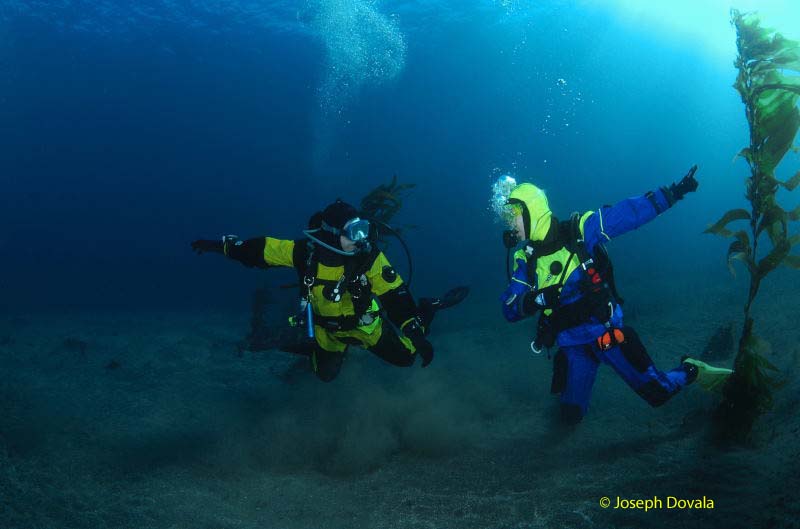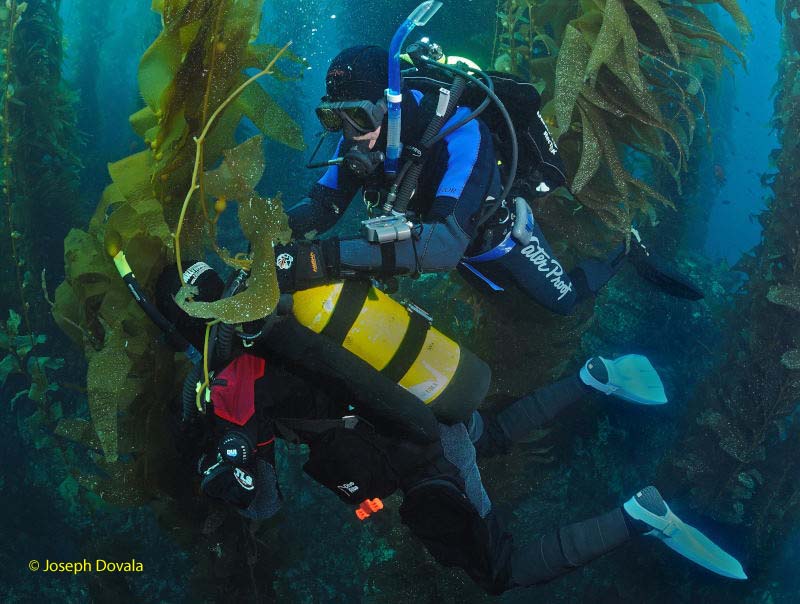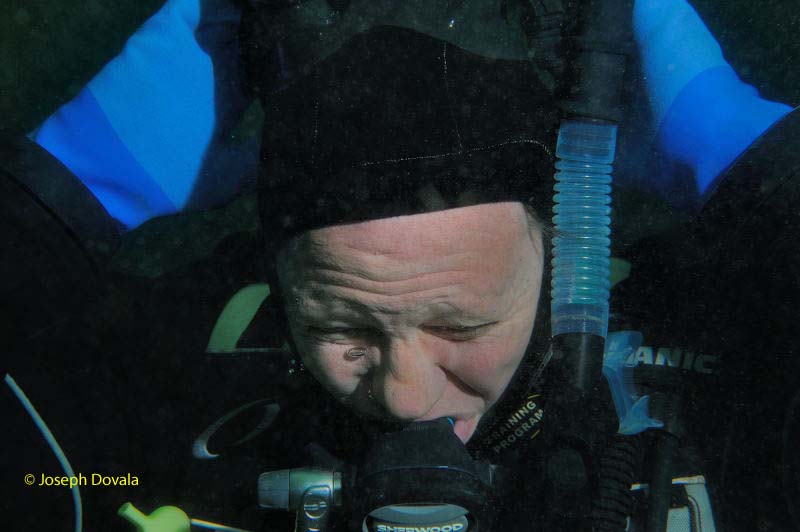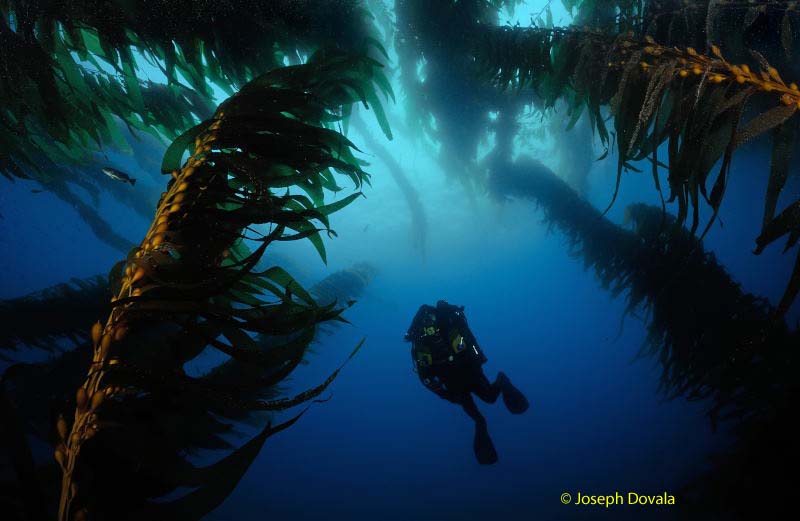
Scuba diver explores power block on sunken trawler Infidel, Catalina Island, California, Eastern Pacific
Self-sufficiency is fairly easy to define: something along the lines of being able to provide for oneself without help from others; by relying on your own capabilities, judgment and resources. Self-reliance allows us to accomplish tasks safely and successfully. It also provides a means to enjoy our activities more, because we are better prepared to deal with unforeseen circumstances. While the meaning of this concept is fairly clear, the ability to put it into practice can be elusive, especially when applied to SCUBA diving. The below true story illustrates how the lack of self-sufficiency and self-awareness can ruin your day.
While on a charter dive boat two divers were swimming on their backs toward some exposed rocks, near the island, before submerging. Unfortunately, neither one of them thought it necessary to check for potential hazards into which they were heading. In a matter of a few minutes both had kelp streaming off their tank valves. To make matters worse, one diver began to twist and turn making a nicely wrapped kelp package of himself. His buddy, in the process of disentangling the kelp from his valve, had managed to lose a fin due to a rotted strap that broke at that moment. His nearby algae-enveloped buddy had by now completely exhausted himself and was hyperventilating. Meanwhile, the now mono-fin diver was unable to assist him because he chose to rapidly descend after his sinking fin, thereby re-entrapping himself on the same kelp he had just removed from his air cylinder. By this time, two of the boat’s crew had arrived and within a few minutes had rectified the problems. Both individuals returned to the vessel and spent most of the day keeping to themselves topside.
Story by Joseph C. Dovala, photos by Dovala images
Most open water diving manuals say something like this….always dive with a buddy who stays nearby at all times. Your buddy assists you with things like putting on and checking your equipment before the dive, helps remind you to check your depth, time and air supply limits, and provides emergency assistance in the unlikely event you need it. Always dive with a buddy has been a training rule second only to never hold your breath on SCUBA. The dive-in-pairs concept was originally designed with the idea that two heads are better than one – but is this really true? In the near disaster above, this concept on face value proved completely false.
Simply making sure that two people are together in the water no more guarantees diver safety than having multiple people in an automobile increases auto safety. This fallacy is most apparent when forced buddy diving is undertaken at a resort or charter boat operation. Being required to dive with a complete stranger does not improve safety, and in fact, has created many close calls and more than few disasters. For a buddy team to provide the proper support and assistance to each other, both divers must know their limitations and dive within them. They also have to remember their training, use well maintained equipment, and be fit to do the diving they are trying to accomplish. This becomes even more important for solo divers. All diving is not the same; any more than taking the back trail up Half Dome in Yosemite is the same as climbing Mount Everest. While not every dive is equal, they all share some of the same requirements for a successful journey.
Most dive accidents and incidents are not the result of a single catastrophic problem, but rather a series of smaller controllable issues which add up to create a crisis. One of the biggest complaints from dive masters in the field is the large number of certified divers who are unable to assemble their gear correctly. If you can’t remember how to properly attach the SCUBA components, it is very likely that you will create a host of problems that will rear up during the dive. For example, if you do not secure the air cylinder to the backpack firmly, you most likely will have it hanging around the back of your legs trying to pull the second stage from your mouth. This is a completely avoidable issue, yet it happens more than it should at resorts and dive boats. Why?
In virtually every case it is either not knowing how to use the cam assembly or not pre-checking the gear before diving. The solution is simple: dive more, or at least set up the gear on a regular basis to stay familiar with the procedure. If you’re renting equipment the dive facility will be more than happy to let you practice before taking it with you. A checklist can be utilized to help remember procedures. Being familiar with SCUBA gear goes hand in hand with knowing how to use it. This is especially true with rental, new, or borrowed equipment. A few minutes spent checking and practicing how to use your gear before the outing can save a lot of grief during the dive. As a buddy team member it’s not enough to know your personal rig but also your buddy’s as well. Purchasing or borrowing a new piece of gear before going on vacation, then not trying it out prior to leaving, is asking for problems.
The idea of being well trained is much more than taking a course and then never putting into practice the skills learned. When was the last time you did a full mask removal and replacement in the ocean? Or used a regulator recovery technique? Chances are the last time you did any of these was during your last basic SCUBA course. It is important to refresh these perishable skills from time to time so as to improve confidence and shake the rust off them. Going over emergency plans with your dive buddy should also include an occasional share air exercise at the end of a diver. Doing this in a non-emergency situation allows you to see and rectify potential problems ahead of time. Visualizing what you would do in in a particular situation is a valuable form of training. Sports psychologists (yes, they do exist) prescribe this technique to their client athletes for improving performance.
While it is nearly impossible to predict exactly how something can happen, by going over several options in your mind, you will have head start if the event were to occur. A clear mind is the most important tool to have. Paying attention to the task at hand significantly reduces the chance for a “silly” error to be made. If you need to concentrate just before making a giant stride then make allowances for it. Don’t fool around or let others distract you until you give yourself the green light. This way, it’s unlikely you’ll jump in with the mask on your forehead and sun glasses on.

Plan your dive, and dive your plan. The more thought that goes into planning the more likely you can deal with contingencies.
One of the most over looked tools that we as divers have is the dive plan. For many divers after the SCUBA course, the only verbal plan is “see you on the bottom.” Agreeing on depth, bottom time and when to surface, are only the barest essentials of what a dive plan can accomplish. For instance, you can discuss procedures on what to do if a weight belt slips at depth or a power inflator gets jammed. The active sharing of information will increase dive knowledge as well as stimulate some interesting discourse. On a recent trip to Mexico, my dive buddy and I talked about catastrophic air loss and blow outs at depth. Although rare this only has to happen once; the very next day my high pressure hose swelled up near the first stage and began to fizzle while waiting to see hammerheads at 90 feet. Since we both carried pony bottles (13cu ft backup cylinders) we decided hold position at the anchor line, and modified our dive plan to spend 10 minutes at 90 feet, air supply/deco requirements permitting. My buddy remained within 10 feet of me and we finished the dive without further incident. We were rewarded with a couple of nice sized hammers who cruised by our location. Had we not discussed air loss at depth, or carrying back up bottles we would have had to ascend early. As a familiar buddy team we know each other’s capabilities and requirements. The more thought that goes into planning the more likely you can deal with contingencies. Having the right equipment for the dive and a well-stocked save-a-dive kit is a big part of this planning.
The right attitude is another vital skill for the self-sufficient diver. This becomes readily apparent when viewing SCUBA accident reports and the somewhat predictable pattern that emerges. Most incidents in a diver’s career spike at the beginning stages and then again out at about 6-10 years’ experience. This typical pattern is also seen in many other above “normal” risk activities, from auto racing to flying. The larger number of situations in the beginning can be attributed to lack of experience and awareness. The big jump later would suggest complacency and the results of cutting corners. We’ve all done it from time to time, you know, where we end up saying “I should’ve known better!” This form of carelessness has a way of sneaking up on oneself. Changing the way one successfully does things often rewards you with problems Borrowing someone else’s gear, without really knowing how to use it, or using equipment that is not up to the job can put safety at risk. An important point to remember when you put your own safety at risk you also put others at risk too. The two kelp divers at the beginning of this article tied up both crewmen in their self-induced distress. If someone else needed help during this period there may not have been any one to render assistance; being an effective member of a buddy team means being responsible for your own safety and well-being. Sometimes that means you need to abort the dive. If it doesn’t feel right – don’t do it!
While the condition of the equipment is very important, our own fitness is paramount for a long and happy career in diving. About a third of diving fatalities (and rising) are the result of heart attacks and preventable circulatory issues. Excess body weight, poor eating habits, and lack of fitness are many times contributing factors. Other predisposing factors can and have contributed to “accidents.” Too much alcohol, dehydration and lack of rest are very common in resort areas. Pushing the computers/tables to their maximum depth and time limits, while not guaranteed, has sent folks on a chamber ride. Seasickness or over heating from putting on exposure protection too early can escalate into problems fairly quickly. It certainly isn’t necessary to be a fitness guru to be in shape for diving; in fact, it doesn’t matter how much weight you can lift or how many laps at the “Y” you can swim, but instead requires knowing your limitations and working within them that counts. Giving yourself an honest self-evaluation about your health, backed up by a routine physical exam, will allow you to define where you sit on the limitation spectrum. It’s then a relatively easy matter to choose the type of diving conditions that will give the greatest satisfaction.
Without a doubt SCUBA diving is a physical activity, and except for possibly high altitude climbing, it’s the only sport that requires you to pack your own atmosphere on your back. Because only so much gas can be squeezed into that cylinder, it’s a number one priority to constantly monitor the breathing supply throughout the dive. You should know within 200/300psi of how much gas you have left at any given time underwater. Honestly discussing air consumption and monitoring each other during a dive will make an out-of-air emergency extremely remote. While it is important to leave some pressure in the cylinder after the dive, it’s more important to ascend slowly and not omit safety stops. Whether you’re doing planned decompression diving or not, it’s good sense to do a safety stop as this forces you to halt the ascent and slow down before returning to atmospheric pressure. The last 20 feet is a critical region where arterial gas embolisms (AGE) are most likely to occur as well. Besides lung expansion injuries, rapid ascents can lead to decompression illness (DCI), headaches, and running into surface obstructions.
Although I have been emphasizing problems with SCUBA, diving continues to enjoy a relatively low accident rate despite larger numbers of participants. Improved equipment, and to some extent, better training have been instrumental in achieving this. However, most of the accidents and scores of near misses that happen every year could still have been avoided with proper diligence. Defining self- sufficiency may be relatively easy, but becoming self-reliant takes training, practice, good equipment, and a willingness to become responsible for all aspects of your diving. Constantly depending on someone else to make sure your gear is setup correctly, or navigating the way back to the boat, will not make the skills necessary to make a proficient diver. In order to help someone else you need to be able to take care of yourself. If both buddies of a dive team are confident in their real abilities and have good communication, then the diving itself will be so much more enriching – as well as just plain fun!
Story by Joseph C. Dovala, photos by Dovala images
All images ©Dovala Images and used with permission
.




